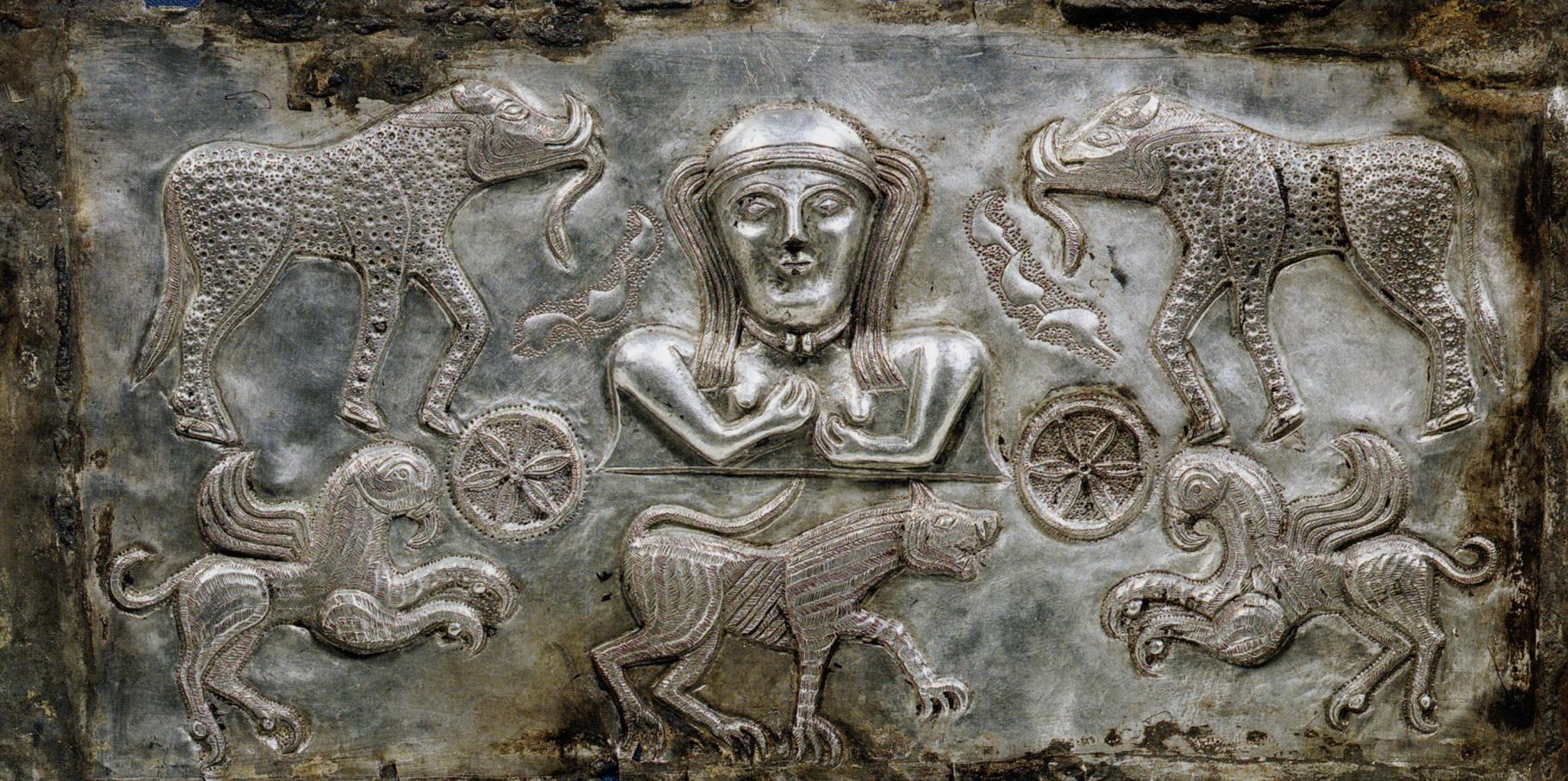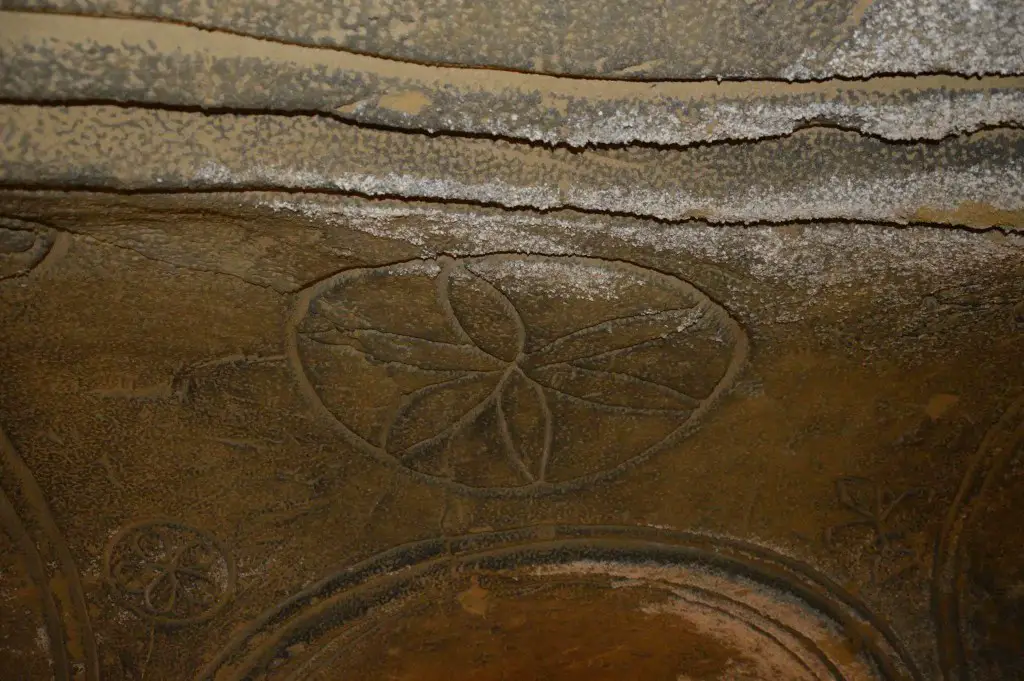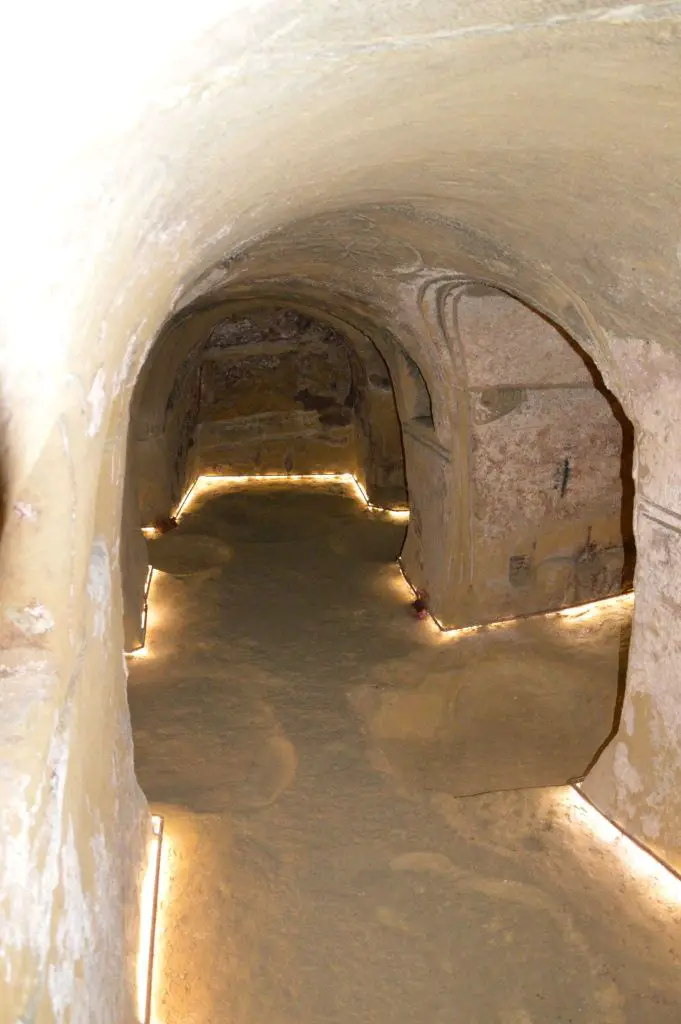In Piagge, in the scattered town of Terre Roveresche in the Marche region, the recent discovery of this hypogeum becomes an opportunity for a journey into hermetic symbolism. An extraordinary and unique place of its kind that leads the visitor to experience the atmosphere of ancient initiation rites.
di John Bigazzi
Author's photo
(except where otherwise specified)
Le Marche, The "beautiful country with sweet hills”As they were described in the fourteenth century by Cecco d'Ascoli, they are one of the Italian regions with the highest index of rurality and, perhaps precisely for this reason, more arcane and untouched by the transformations of modernity. A natural and ancient land that is characterized "for the typical succession of hilly reliefs, sloping from the inside towards the sea, with long, tortuous and fertile valleys, and with a dozen rivers that descend parallel their short course, insinuating themselves between hills and hills, in flat, fertile furrows, and only where it was an obstacle to other mountains, the breach was made, deep cuts, long precipitous gorges, as in the course of the Esino the "Rossa", of the Metauro the Furlo, of the Tronto l'Arquata". A geologically young, blond and tufaceous land, which over the centuries has lent itself to being modeled by its inhabitants, as we see in the dozens of medieval defensive fortresses that characterize many of these villages built on the slope of the mountains or on the hills from which you can enjoy sweeping views of the glaucous Adriatic horizon.
This toponym of Piagge which we also find in other areas of Apennine Italy, as suggested by the historian Giulio Amadio from Ascoli in the essay Toponymy of the Marche, it would derive from the low Latin plagiarism (slope, mountain coast), hence also the Italian beach, referring to those large spaces between the town and the real countryside that were popular meeting places for the cults of the pagus as on the occasion of paganalie in what was theAger Gallicus of the Augustan Regio VI.

It is no coincidence that in Piagge, in the municipality of Terre Roveresche (PU), we find this extraordinary hypogeum, unique of its kind, of which there is no news before its discovery by a local architect who, doing historical research in the area, discovered in 1996 this underground space used as a sausage warehouse under the village butcher's shop. Characterized by an exceptional state of conservation despite the friability of the rock in which it was excavated, the hypogeum has been open to the public since 2016.
One of the first things that strike, after having descended the steep tuff staircase that leads into this narrow underground environment and having become accustomed to the darkness that reigns there, are the solar symbols imprinted on the limestone positioned above six of the seven lateral niches and on the vault. barrel of the cave as if to represent a starry sky. This ancient symbol, also called Flower of Life, Celtic Rose or Sun of the Alps, represents the solar star and its creative power, a talisman with superstitious and protective functions common to many ancient civilizations. So we find it in the Etruscan context in the funerary stele of Vetulonia, from the second half of the seventh century BC, in which a warrior prince is seen holding a double ax in his right, while in his left he holds an enormous round shield on which the six-petaled flower is drawn.


We find it among the Celts, as in the silver panel called the elephant goddess of the Cauldron of Gundestrup from the XNUMXst century BC It is not uncommon to come across the Early Middle Ages, with the Lombards, who adopted it in their conversion to Christianity as a relic of their pagan tradition. Here it is then in the superb Romanesque parish church of Gropina near Loro Ciuffenna (AR) magnificently sculpted on the sumptuous Lombard ambo. And going further, in medieval times, there are dozens of examples: in the parish churches of the countryside, in the cloisters, in the Roman cosmatesque polychrome decorations, in the churches and abbeys throughout Italy.

Although it is possible that this place was used in medieval times for the initiation rites of knightly orders, like that of the Templars, an older origin is likely and refers to the widespread diffusion in the Roman imperial era of eastern solar cults such as the Mithraism and, following the decrees of Theodosius which abolished paganism, at the birth of the first paleochristian cults. It is typical of Mithraism the gathering of communities of adepts in places that had the double characteristic of being occult and underground which were called antrum. Mithraism was a mystery religion that originated from cult of the Persian god of celestial light Mithra which had a great diffusion and an autonomous development in the lower empire especially in the military field among the auxiliary light cavalry departments which, regionally recruited, introduced it in the provinces of the empire even very far from their homeland, where they settled for years, think of the mithraeum of Londinium (London). In 175 Marcus Aurelius sent several thousand Alano-Sarmatians in Britain to fight the Caledonians at Hadrian's Wall, these units were subsequently transferred to Brittany to quell the warlike and irreducible Armoricans who had revolted.
The popular narrative tradition of these Sarmatians settled in Western Europe as auxiliary of the imperial legions it constituted the historical nucleus of the Arthurian cycle (Littleton, Thomas and Malcor). The Alans of Brittany thus became the backbone of the Breton nobility and later, together with the Normans, they defeated the Saxons at the Battle of Hastings in 1066. Their ethnonym echoes in the English nobility in the FitzAlan linked to the lineage of Stuart. These Sarmatians spoke an Iranian language of Indo-European lineage akin to Scythian. The Greeks and Romans, who feared them but at the same time admired them for their valor in battle, mocked them for their funny way of speaking that they ape in bar-bar, thus giving rise to the term "barbarians“, Then applied to any people extraneous to the Greco-Roman world. From an inscription found in the Crimea it seems that the Sarmatians worshiped "the seven gods" a practice also attested among the Scythians, one of whom was the warlord corresponding to the Roman god Mars which, as the historian Ammiano Marcellino wrote in the fourth century, they adored incarnate in the form of a sword driven into the stone, a ritual that seems to coincide with the birth of Mithra from a rock with the dagger and the torch.

This orientalization in the second century interested Rome itself, alae di equites singulares made up of Celtic knights, Germans, Pannonians, Dacians, Thracians they served in the praetorian guard transplanting their exotic gods into the city. Thus Mithraism, which saw the emperors Commodus and Julian among the followers, became more and more in vogue in Rome. This cult, warrior and hierarchical, was reserved exclusively for men, starting from seven years of age, who had to undertake a long initiatory path consisting of seven degrees associated with as many planets: chorax, crow, or the neophyte (Mercury); Cryphius o Nymphus, boyfriend (Venus); Miles, soldier (Mars); Leo, lion (Jupiter), Persians, Persian (Moon); Heliodrome, solar courier (Sun); Padre, father (Saturn) the highest degree. Contrary to Christianity, Mithraism did not proselytize, the communities were formed by a few dozen followers initiated into the mysteries, the neophytes swore in the manner of the soldiers with sacramentum and ever since the initiate became part of the "sacred militia of the god of light". In the Mithraic conception, kingship sprang from the rock, an expression of the unshakable faith of a race that was saved from the flood. Mithra, petra genitrix, was born from the stone, in the same way in which Christ is called the cornerstone of the Church. Mithraism and Christianity, which present not a few similarities but also many differences, were contemporary religions in competition with each other, finding appeal in the same social strata of the people, the humble and the forgotten, who were given a concrete prospect of salvation from the miseries of everyday life.
Mithraism was already attested in from the presence of other Mithrae, one of these was located in Fano (PU), the ancient Fanum Fortunae, an important nerve center of the trade routes with the eastern Mediterranean, still today the city is the seat of an ancient Orthodox Christian community. Of this mithraeum, which must have been built in correspondence with the Cathedral, remains today an artefact in the archaeological museum of the city. Another mithraeum stood, according to the thesis proposed by the archaeologist Camillo Ramelli, at the Abbey of Santa Croce dei Conti in Sassoferrato (AN), the ancient one Sentium. Here the Benedictine monks built the Abbey by reusing columns, tombstones, capitals, stones from the underlying Mithraeum and thus "Christianizing" everything, but in this way these elements, relics of ancient pagan cults, survived over the centuries in the shadow of a hostile environment .


From the architectural point of view, the hypogeum is characterized by an organized basilica-type plan consisting of a central space onto which small spaces overlook in a symmetrical way, on the sides there are six small votive niches at a man's height which probably contained all interior of terracotta bas-reliefs or votive statuettes. In the hypothesis, in the central part, in correspondence with the large six-petal flower imprinted on the barrel vault, there was a small one column that served as an altar for the rites, the surface was frescoed with the usual representation of the tauroctony, the ritual killing of the bull of the Mithraic rite. We can now try to imagine the atmosphere of these initiation rites from the words of the'emperor Julian, the last non-Christian:
"The darkness crossed by sudden flashes of light, long silences broken by murmurs, voices, shouts, and then the din of music cadenced by a repetitive rhythm, scents of incense and other fragrances, objects animated by magic formulas, doors that they open and close by themselves, statues that come to life and a lot of torch fire. "
This cave constitutes a unicum of its kind and crystallizes forever that moment of the great crisis of the ancient world in which the Romanized West could have taken a different direction than that represented by Christianity which in the end prevailed. What it essentially was the last spiritual reaction of the ancient tradition before disintegrating forces began to take over.

A comment on "Arcane Italy: the hypogeum of Piagge and the Mithraic Mysteries"